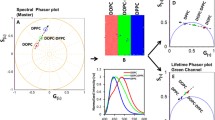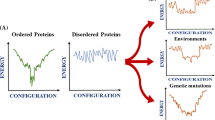Abstract
The interaction of protein and peptide amyloid oligomers with membranes is thought to be one of the mechanisms contributing to cellular toxicity. However, techniques to study these interactions in the complex membrane environment of live cells are lacking. Spectral phasor analysis is a recently developed biophysical technique that can enable visualisation and analysis of membrane-associated fluorescent dyes. When the spectral profile of these dyes changes as a result of changes to the membrane microenvironment, spectral phasor analysis can localise those changes to discrete membrane regions. In this study, we investigated whether spectral phasor analysis could detect changes in the membrane microenvironment of live cells in the presence of fibrillar aggregates of the disease-related Aβ42 peptide or the functional amyloid neurokinin B. Our results show that the fibrils cause distinct changes to the microenvironment of nile red associated with both the plasma and the nuclear membrane. We attribute these shifts in nile red spectral properties to changes in membrane fluidity. Results from this work suggest that cells have mechanisms to avoid or control membrane interactions arising from functional amyloids which have implications for how these peptides are stored in dense core vesicles. Furthermore, the work highlights the utility of spectral phasor analysis to monitor microenvironment changes to fluorescent probes in live cells.




Similar content being viewed by others
Data availability
The datasets generated during and/or analysed during the current study are available from the corresponding author upon reasonable request.
References
Riek, R., & Eisenberg, D. S. (2016). The activities of amyloids from a structural perspective. Nature, 539, 227–235. https://doi.org/10.1038/nature20416
Knowles, T. P., Vendruscolo, M., & Dobson, C. M. (2014). The amyloid state and its association with protein misfolding diseases. Nature Reviews Molecular Cell Biology, 15, 384–396. https://doi.org/10.1038/nrm3810
Itoh, N., Takada, E., Okubo, K., Yano, Y., Hoshino, M., Sasaki, A., Kinjo, M., & Matsuzaki, K. (2018). Not oligomers but amyloids are cytotoxic in the membrane-mediated amyloidogenesis of amyloid-beta peptides. ChemBioChem, 19, 430–433. https://doi.org/10.1002/cbic.201700576
Sciacca, M. F. M., Tempra, C., Scollo, F., Milardi, D., & La Rosa, C. (2018). Amyloid growth and membrane damage: Current themes and emerging perspectives from theory and experiments on Abeta and hIAPP. Biochimica et Biophysica Acta - Biomembranes, 1860, 1625–1638. https://doi.org/10.1016/j.bbamem.2018.02.022
Walsh, P., Vanderlee, G., Yau, J., Campeau, J., Sim, V. L., Yip, C. M., & Sharpe, S. (2014). The mechanism of membrane disruption by cytotoxic amyloid oligomers formed by prion protein(106-126) is dependent on bilayer composition. Journal of Biological Chemistry, 289, 10419–10430. https://doi.org/10.1074/jbc.M113.515866
Chuang, E., Hori, A. M., Hesketh, C. D., & Shorter, J. (2018) Amyloid assembly and disassembly. Journal of Cell Science, 131, jcs189928. https://doi.org/10.1242/jcs.189928
Maji, S. K., Perrin, M. H., Sawaya, M. R., Jessberger, S., Vadodaria, K., Rissman, R. A., Singru, P. S., Nilsson, K. P., Simon, R., Schubert, D., Eisenberg, D., Rivier, J., Sawchenko, P., Vale, W., & Riek, R. (2009). Functional amyloids as natural storage of peptide hormones in pituitary secretory granules. Science, 325, 328–332. https://doi.org/10.1126/science.1173155
Nespovitaya, N., Gath, J., Barylyuk, K., Seuring, C., Meier, B. H., & Riek, R. (2016). Dynamic assembly and disassembly of functional beta-endorphin amyloid fibrils. Journal of the American Chemical Society, 138, 846–856. https://doi.org/10.1021/jacs.5b08694
Jayawardena, B. M., Jones, M. R., Hong, Y., & Jones, C. E. (2019). Copper ions trigger disassembly of neurokinin B functional amyloid and inhibit de novo assembly. Journal of Structural Biology, 208, 107394 https://doi.org/10.1016/j.jsb.2019.09.011
Golfetto, O., Hinde, E., & Gratton, E. (2015). The Laurdan spectral phasor method to explore membrane micro-heterogeneity and lipid domains in live cells. Methods in Molecular Biology, 1232, 273–290. https://doi.org/10.1007/978-1-4939-1752-5_19
Fereidouni, F., Bader, A. N., & Gerritsen, H. C. (2012). Spectral phasor analysis allows rapid and reliable unmixing of fluorescence microscopy spectral images. Optics Express, 20, 12729–12741. https://doi.org/10.1364/OE.20.012729
Andrews, L. M., Jones, M. R., Digman, M. A., & Gratton, E. (2013). Spectral phasor analysis of Pyronin Y labeled RNA microenvironments in living cells. Biomedical Optics Express, 4, 171–177. https://doi.org/10.1364/BOE.4.000171
Sediqi, H., Wray, A., Jones, C. E., & Jones, M. R. (2018). Application of spectral phasor analysis to sodium microenvironments in myoblast progenitor cells. PLoS One, 13, e0204611 https://doi.org/10.1371/journal.pone.0204611
Fereidouni, F., Bader, A. N., Colonna, A., & Gerritsen, H. C. (2014). Phasor analysis of multiphoton spectral images distinguishes autofluorescence components of in vivo human skin. Journal of Biophotonics, 7, 589–596. https://doi.org/10.1002/jbio.201200244
Malacrida, L., Astrada, S., Briva, A., Bollati-Fogolin, M., Gratton, E., & Bagatolli, L. A. (2016). Spectral phasor analysis of LAURDAN fluorescence in live A549 lung cells to study the hydration and time evolution of intracellular lamellar body-like structures. Biochimica et Biophysica Acta, 1858, 2625–2635. https://doi.org/10.1016/j.bbamem.2016.07.017
Sameni, S., Malacrida, L., Tan, Z., & Digman, M. A. (2018). Alteration in fluidity of cell plasma membrane in huntington disease revealed by spectral phasor analysis. Scientific Reports, 8, 734 https://doi.org/10.1038/s41598-018-19160-0
Sena, F., Sotelo-Silveira, M., Astrada, S., Botella, M. A., Malacrida, L., & Borsani, O. (2017). Spectral phasor analysis reveals altered membrane order and function of root hair cells in Arabidopsis dry2/sqe1-5 drought hypersensitive mutant. Plant Physiology and Biochemistry, 119, 224–231. https://doi.org/10.1016/j.plaphy.2017.08.017
Shahzad, R., Jones, M. R., Viles, J. H., & Jones, C. E. (2016). Endocytosis of the tachykinin neuropeptide, neurokinin B, in astrocytes and its role in cellular copper uptake. Journal of Inorganic Biochemistry, 162, 319–325. https://doi.org/10.1016/j.jinorgbio.2016.02.027
Menon, R., Christofides, K., & Jones, C. E. (2020). Endocytic recycling prevents copper accumulation in astrocytoma cells stimulated with copper-bound neurokinin B. Biochemical and Biophysical Research Communications, 523, 739–744. https://doi.org/10.1016/j.bbrc.2019.12.087
Greenspan, P., & Fowler, S. D. (1985). Spectrofluorometric studies of the lipid probe, nile red. Journal of Lipid Research, 26, 781–789
Stringari, C., Cinquin, A., Cinquin, O., Digman, M. A., Donovan, P. J., & Gratton, E. (2011). Phasor approach to fluorescence lifetime microscopy distinguishes different metabolic states of germ cells in a live tissue. Proceedings of the National Academy of Sciences of the United States of America, 108, 13582–13587. https://doi.org/10.1073/pnas.1108161108
Mukherjee, S., Raghuraman, H., & Chattopadhyay, A. (2007). Membrane localization and dynamics of Nile Red: Effect of cholesterol. Biochimica et Biophysica Acta, 1768, 59–66. https://doi.org/10.1016/j.bbamem.2006.07.010
Zentgraf, H., Deumling, B., Jarasch, E. D., & Franke, W. W. (1971). Nuclear membranes and plasma membranes from hen erythrocytes. I. Isolation, characterization, and comparison. Journal of Biological Chemistry, 246, 2986–2995
Almeida, P. F., Pokorny, A., & Hinderliter, A. (2005). Thermodynamics of membrane domains. Biochimica et Biophysica Acta, 1720, 1–13. https://doi.org/10.1016/j.bbamem.2005.12.004
Wardhan, R., & Mudgal, P. (2017). Textbook of membrane biology. 2017. Singapore: Springer
Raghuraman, H., & Chattopadhyay, A. (2007). Melittin: A membrane-active peptide with diverse functions. Bioscience Reports, 27, 189–223. https://doi.org/10.1007/s10540-006-9030-z
Sabapathy, T., Deplazes, E., & Mancera, R. L. (2020) Revisiting the interaction of melittin with phospholipid bilayers: The effects of concentration and ionic strength. International Journal of Molecular Sciences, 21, 746. https://doi.org/10.3390/ijms21030746
van den Bogaart, G., Guzman, J. V., Mika, J. T., & Poolman, B. (2008). On the mechanism of pore formation by melittin. Journal of Biological Chemistry, 283, 33854–33857. https://doi.org/10.1074/jbc.M805171200
Yang, Z., Choi, H., & Weisshaar, J. C. (2018). Melittin-induced permeabilization, re-sealing, and re-permeabilization of E. coli membranes. Biophysical Journal, 114, 368–379. https://doi.org/10.1016/j.bpj.2017.10.046
Xue, W. F., Hellewell, A. L., Gosal, W. S., Homans, S. W., Hewitt, E. W., & Radford, S. E. (2009). Fibril fragmentation enhances amyloid cytotoxicity. Journal of Biological Chemistry, 284, 34272–34282. https://doi.org/10.1074/jbc.M109.049809
Jones, C. E., Underwood, C. K., Coulson, E. J., & Taylor, P. J. (2007). Copper induced oxidation of serotonin: analysis of products and toxicity. Journal of Neurochemistry, 102, 1035–1043. https://doi.org/10.1111/j.1471-4159.2007.04602.x
Mishra, R., Sjolander, D., & Hammarstrom, P. (2011). Spectroscopic characterization of diverse amyloid fibrils in vitro by the fluorescent dye Nile red. Molecular BioSystems, 7, 1232–1240. https://doi.org/10.1039/c0mb00236d
Segota, S., Vojta, D., Pletikapic, G., & Baranovic, G. (2015). Ionic strength and composition govern the elasticity of biological membranes. A study of model DMPC bilayers by force- and transmission IR spectroscopy. Chemistry and Physics of Lipids, 186, 17–29. https://doi.org/10.1016/j.chemphyslip.2014.11.001
Pinho, C. M., Teixeira, P. F., & Glaser, E. (2014). Mitochondrial import and degradation of amyloid-beta peptide. Biochimica et Biophysica Acta, 1837, 1069–1074. https://doi.org/10.1016/j.bbabio.2014.02.007
Mastroeni, D., Chouliaras, L., Grover, A., Liang, W. S., Hauns, K., Rogers, J., & Coleman, P. D. (2013). Reduced RAN expression and disrupted transport between cytoplasm and nucleus; a key event in Alzheimer’s disease pathophysiology. PLoS One, 8, e53349 https://doi.org/10.1371/journal.pone.0053349
Acknowledgements
The authors would like to acknowledge the Advanced Materials Characterisation Facility (AMCF) of Western Sydney University for access to its instrumentation and staff. R.M. acknowledges support from Australian Rotary Health. B.M.J. acknowledges the support of a Western to the World Postgraduate Scholarship. In memory of Fredrick Jones (9 March 1936 to 2 May 2022).
Author information
Authors and Affiliations
Corresponding author
Ethics declarations
Conflict of Interest
The authors declare no competing interests.
Additional information
Publisher’s note Springer Nature remains neutral with regard to jurisdictional claims in published maps and institutional affiliations.
Supplementary information
Rights and permissions
Springer Nature or its licensor holds exclusive rights to this article under a publishing agreement with the author(s) or other rightsholder(s); author self-archiving of the accepted manuscript version of this article is solely governed by the terms of such publishing agreement and applicable law.
About this article
Cite this article
Jayawardena, B.M., Menon, R., Jones, M.R. et al. Spectral Phasor Analysis of Nile Red Identifies Membrane Microenvironment Changes in the Presence of Amyloid Peptides. Cell Biochem Biophys 81, 19–27 (2023). https://doi.org/10.1007/s12013-022-01105-0
Received:
Accepted:
Published:
Issue Date:
DOI: https://doi.org/10.1007/s12013-022-01105-0




